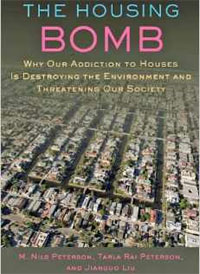COLLEGE STATION – If the authors of a recently published book have their way, “keeping up with the Joneses” may have more to do with who has the cheapest utility bills than who’s got the biggest house.

The scientists involved are Dr. Tarla Peterson, Boone and Crockett Chair of Wildlife and Conservation Policy at Texas A&M University, College Station; and lead author Dr. Nils Peterson, a Texas A&M graduate now with the North Carolina State University fisheries, wildlife and conservation biology program at Raleigh. The Petersons, a mother and son team, were joined by Dr. Jianguo Liu, director of the Center for Systems Integration and Sustainability, fisheries and wildlife department, Michigan State University.
The book initially stemmed from Nils Peterson’s dissertation on land-use decision making around Yellowstone National Park. He found the people most concerned with the ecosystems there were also the ones who built their houses in the most fragile locations, big houses with few people living in them. The areas included wetlands, riparian areas and low elevation hillsides, all critical habitats for many wildlife species, including elk and upland game birds.
The Yellowstone research was balanced with an environmental study conducted by Liu focusing on giant panda conservation areas in China, which are touted as a model for coupled human and natural systems.
“The Yellowstone findings indicated the more highly educated people are, the more prone they are to overbuilding in these sensitive areas, which goes against what is normally believed,” Nils Peterson said.
Johns Hopkins University Press asked the scientists to expand on the Yellowstone paper and write a housing/environment-type book based on the project.
The book is available from Amazon at http://www.amazon.com/The-Housing-Bomb-Environment-Threatening/dp/1421410656
Tarla Peterson said the book’s name is inspired by an earlier work called The Population Bomb, written by Stanford University professor Dr. Paul Ehrlich and his wife, Anne, in 1968. That book centered around consequences associated with the unchecked world population growth occurring at the time.
“So, the really short story now is that the explosive growth in population is slowing, but the number of houses with fewer people per house is going up. As that number falls from the previous five per household to the current 2.5, there is a huge potential issue associated with billions of people worldwide needing more housing so land needs will double as will demands on the environment,” said Nils Peterson.
The Petersons said the book touches on green building, but the larger focus is on development locations and local politics.
They said Yellowstone lies in the Intermountain West, which like Texas, is staunchly pro-property rights oriented.
“That way of thinking has pluses and minuses,” Nils Peterson said. “In the Yellowstone area, one of the minuses in terms of housing is that most of the local people in the community were really unhappy with the way development was occurring in the sensitive ecological areas, largely because it impacted their access to traditional hunting and fishing areas.
“But they were also so entrenched in the ideology of property rights that they weren’t willing to discuss community-level planning because they considered a comprehensive plan as a way of infringing on property rights. It’s put them in a real bind, because they couldn’t work toward what they wanted in their community because of their values.”
The Petersons said on a much larger scale Texas is also suffering from the problem of “the best places to live” turning into a mess.
“That’s what you see around Austin,” Nils Peterson said. “There’s been a lot of press lately about how the traffic system there is doomed to fail, because growth has happened so crazily and in such an unplanned fashion. So, I think Texas is a great example where yes, you’ve got to respect property rights, but you can’t let it prevent you from doing urban planning.
“Austin considers itself progressive, but it’s also a city of suburbs that haven’t been able to work together to accomplish much in terms of systematic planning for growth.”
The Petersons said the latter part of the book touches on ways to address problems that arise when regional development lacks regional government oversight.
“Many point to Portland, Ore. as a good example on how best to control urban growth boundaries to protect agricultural lands around those areas,” said Tarla Peterson. “But their effort initially backfired, because when they created those boundaries, those wanting to live in a suburb just crossed the state line into Washington, where there was no such jurisdiction. So without the needed regional cooperation, instead of the status quo problem, which was simply urban sprawl, they created super-duper mega-sprawl.”
The scientists see a huge housing issue looming and offer three ways to deal with it. The first is to live where you are and make it better. The second deals with conservation subdivisions that protect fragile environments, valuable agricultural lands and aquifers. And the third is to live in more densely populated urban centers.
“We admit that we are a long way from making it so people really want to live in those really densely populated urban centers, the Detroits and Baltimores,” Nils Peterson said. “There is a push to develop dense housing areas around major points of transportation, but to motivate people to live there you must convince them it’s going to save them money and time. But perhaps most important, we must figure out a way to make them compete.
“We’ve got this keeping up with the Joneses mind-set and we’re more than happy to compete with the coolest counter tops, biggest vaulted ceilings and all those other things we find important.
“However, if we could move that way of thinking so people would compete on who had the most efficient house and cheapest utilities, I guarantee you, both the drain on the environment and our wallets would go down a lot. But at the city, state and federal level, there’s still much work to be done in terms of figuring out just how to motivate people to address these core issues.”